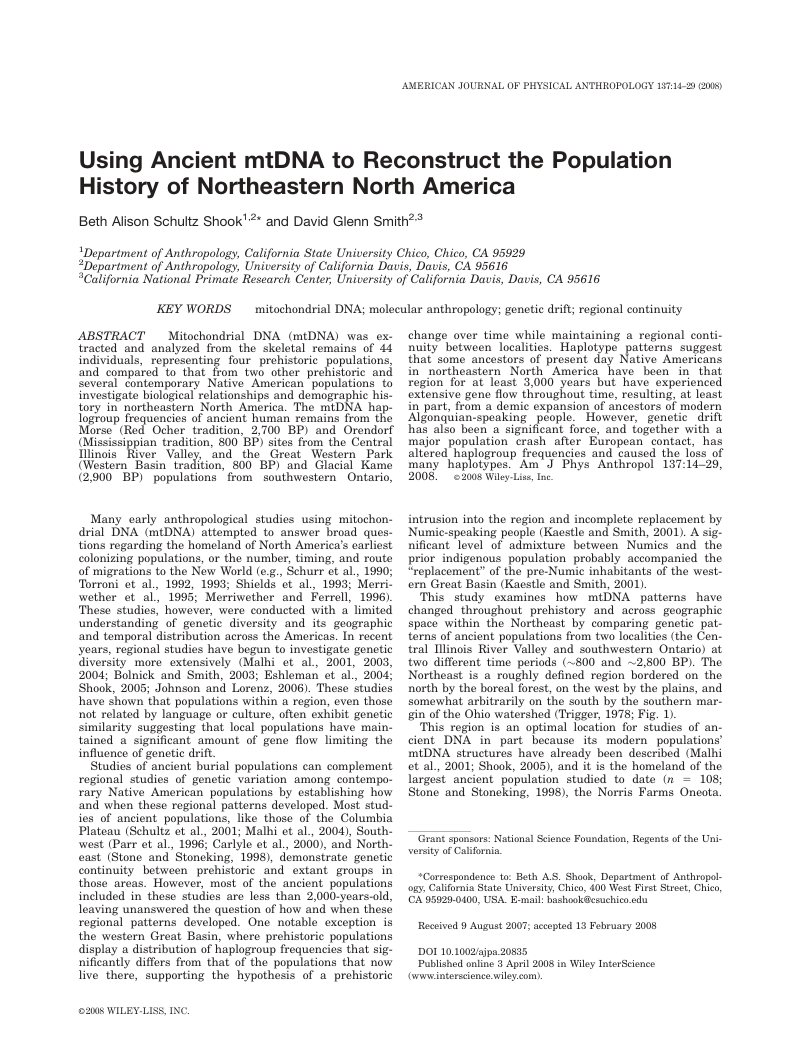Beth Alison Schultz Shook and David Glenn Smith describe how genetic drift and population bottlenecks have affected the genome of modern Native Americans.
- Type
- Academic / Technical Report
- Source
- Beth Alison Schultz Shook Non-LDS
- Hearsay
- Direct
- Reference
Beth Alison Schultz Shook and David Glenn Smith, “Using Ancient MtDNA to Reconstruct the Population History of Northeastern North America,” American Journal of Physical Anthropology 137, no. 1 (2008): 14–29
- Scribe/Publisher
- American Journal of Physical Anthropology
- People
- David Glenn Smith, Beth Alison Schultz Shook
- Audience
- Reading Public
- Transcription
Mitochondrial DNA (mtDNA) was extracted and analyzed from the skeletal remains of 44 individuals, representing four prehistoric populations, and compared to that from two other prehistoric and several contemporary Native American populations to investigate biological relationships and demographic history in northeastern North America. The mtDNA haplogroup frequencies of ancient human remains from the Morse (Red Ocher tradition, 2,700 BP) and Orendorf (Mississippian tradition, 800 BP) sites from the Central Illinois River Valley, and the Great Western Park (Western Basin tradition, 800 BP) and Glacial Kame (2,900 BP) populations from southwestern Ontario, change over time while maintaining a regional continuity between localities. Haplotype patterns suggest that some ancestors of present day Native Americans in northeastern North America have been in that region for at least 3,000 years but have experienced extensive gene flow throughout time, resulting, at least in part, from a demic expansion of ancestors of modern Algonquian-speaking people. However, genetic drift has also been a significant force, and together with a major population crash after European contact, has altered haplogroup frequencies and caused the loss of many haplotypes.
. . .
Only 19.7% of the 61 ancient haplotypes in the Northeast are shared with extant individuals, somewhat lower than the rate (36%) estimated by Malhi et al. (2002) for all of North America. Additionally, ancient populations exhibit a higher frequency of unique haplotypes than modern populations and much of the diversity of haplogroups B and D have been lost, suggesting that genetic drift has been a significant force over time. As reported for Southeastern populations (Bolnick and Smith, 2003), it is also likely that much of the genetic diversity was lost after European contact when population levels dropped from between two and ten million to approximately a quarter million by the year 1890 as a result of disease, warfare, and depletion of resources (Snipp, 1989; Calloway, 1997; Jones, 2003).
- Source Link
- https://pubmed.ncbi.nlm.nih.gov/18386794/
- Citations in Mormonr Qnas
The B. H. Roberts Foundation is not owned by, operated by, or affiliated with the Church of Jesus Christ of Latter-day Saints.

